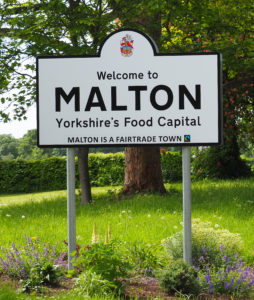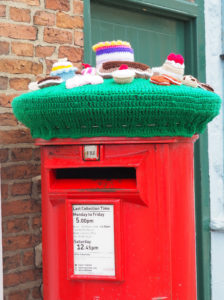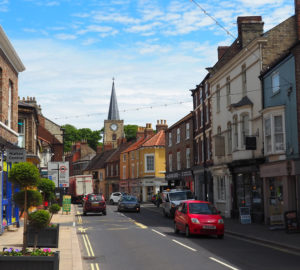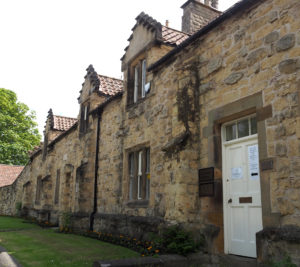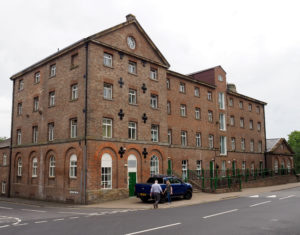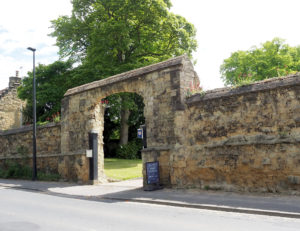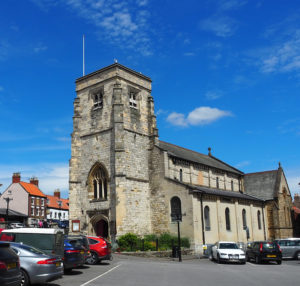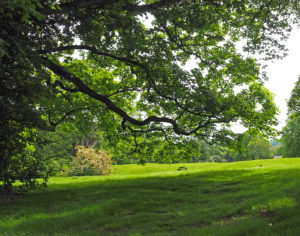On the banks of the River Derwent, this is often referred to as New Malton, to distinguish it from it’s older neighbour “Old Malton.”:http://www.silvertraveladvisor.com/travel-product/place/209398
It is a traditional market town which has reinvented and reinvigorated itself over the last few years as ‘Yorkshire’s Food Capita’ with a lot of small family run food shops. The town had become run down and sad, but now has a pride in itself and its appearance. Even the top of the post box was decorated with crocheted food items.
The Romans had an auxiliary fort here, Derventio, on the north bank of the river, in the area now known as Orchard Fields. The only remains are a few earthworks.
This was also the site for an C11th motte and bailey castle. This dominated the surrounding countryside and controlled the river crossing and road system. A walled settlement grew up by the castle and the present parish boundary still follows the line of the walls.
The castle was later rebuilt in stone and supported Matilda against Stephen during the unsettled times of 1138. The castle was held by the Barons in their war against against King John, which led to the signing of the Magna Carta. The castle was destroyed by the forces of Robert the Bruce in 1322.
The castle was replaced by a spectacular new house in 1602. This was inherited by two sisters who fell out over ownership and took their case to the County Sheriff. He ordered the house to be demolished and the stones to be split between the two women. All that was left was the boundary wall and the gatehouse which has been extensively restored and is now a “hotel.”:https://theoldlodgemalton.co.uk/
Malton grew and thrived during the Middle Ages, with a market here by 1238. The town centre still retains the original cross pattern of streets leading to the gates in the walls.
As the settlement grew, the monks of “St Mary’s Priory”:https://www.silvertraveladvisor.com/travel-product/attraction/209390 built two Chapels of Ease to serve the population. The monks may have preferred to build two smaller subservient churches than one large and possibly rival church. “St Michael’s Church”:https://www.silvertraveladvisor.com/travel-product/attraction/209402 was built in the Market Place. St Leonard’s Church was built near the castle. They didn’t become separate parishes until 1855.
The borough of Malton was purchased in 1713 by the Hon Thomas Watson Wentworth, a wealthy landowner, after becoming an MP for Malton. His family invested heavily in the town and really put it on the map .
His son, the First Marquess of Rockingham, carried out extensive work to make the River Derwent navigable up to Malton. He also built “The Talbot Hotel”:https://www.silvertraveladvisor.com/review/place/146845-review-malton-and-the-talbot-hotel for those attending the races. This was later extended to cater for those taking the waters at nearby Malton Spa. He also commissioned the building of the Town Hall in the Market Place.
The second Marquess made further improvements to the Derwent River Navigation and was responsible for the creation of a turnpike road between York and Scarborough which passed through Malton. Streets in the town were cobbled and the bridge over the river to Norton was widened. He also served as Prime Minister twice.
A family Trust, the Fitzwilliam Malton Estate, now owns and manages much of the property in Malton, from their office on Old Malton Road.
The areas grew rapidly, trading in coal, corn and butter. The improvements to the River Derwent allowed extensive barge traffic carrying goods and large warehouses were built to store these.
The railway arrived in 1845 with the opening of the York to Scarborough line. The now closed Malton and Driffield branch soon followed and barge traffic declined.
Gas lighting arrived in 1832. and electric light by 1893. A waterworks supplied residents with water by 1867.
Malton continues to be a thriving market centre for the area today with a Saturday market and monthly farmer’s market. It also has a busy livestock market with weekly sales.
